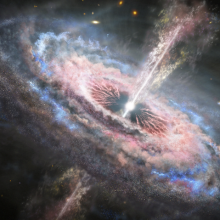Galaxies may not need to crash and smash into each other as much as previously thought to spawn new galaxies, according to two new scientific studies.
Astronomers used the James Webb Space Telescope, the leading infrared observatory in space, to peer into the murk around the Spiderweb protocluster, a famous metropolis of galaxies in the universe, to study what it takes to form these complex cosmic neighborhoods. Webb is a partnership between NASA and its European and Canadian counterparts.
The protocluster is about 10 billion light-years away from Earth and exists during a period of the universe's history known as "cosmic noon." In this region during the time — just 3 billion years after the Big Bang — more than a hundred galaxies were under construction.
What scientists discovered surprised them: Mergers and collisions weren't that important for the process.
"Now we think that star formation can be explained by the accumulation of gas in various parts of the large-scale structures," said Helmut Dannerbauer, one of the researchers at the Instituto de Astrofísica de Canarias in Spain, in a statement.

Scientists have frequently trained telescopes on the Spiderweb protocluster. That's because in our neck of the universe, closer galaxy clusters to the Milky Way tend to be old and slowing down. But the Spiderweb is a growing, busy hub of activity, revealing more clues about the steps and ingredients needed to form new galaxies.
The new research is published in the Astrophysical Journal. The scientists' observations that dust that can turn into new stars is mostly coming from a smooth hydrogen gas accumulation across the region. This finding suggests that gravitational interactions aren't that necessary to produce dust.

Webb was built to see the early universe, detecting invisible light at infrared wavelengths. Dust and gas in space obscures the view to extremely distant and inherently dim light sources, but infrared waves can pierce through the clouds. One Webb scientist likened the strength of the telescope to being able to sense the heat of a single bumblebee on the moon.
In addition to revealing new insights into galaxy formation, Webb's penetrating gaze detected two-dozen previously unseen galaxies, published in a companion paper in the Astrophysical Journal. The team is planning follow-up light spectrum studies with Webb to learn more about those galaxies' chemical compositions.
Topics NASA













